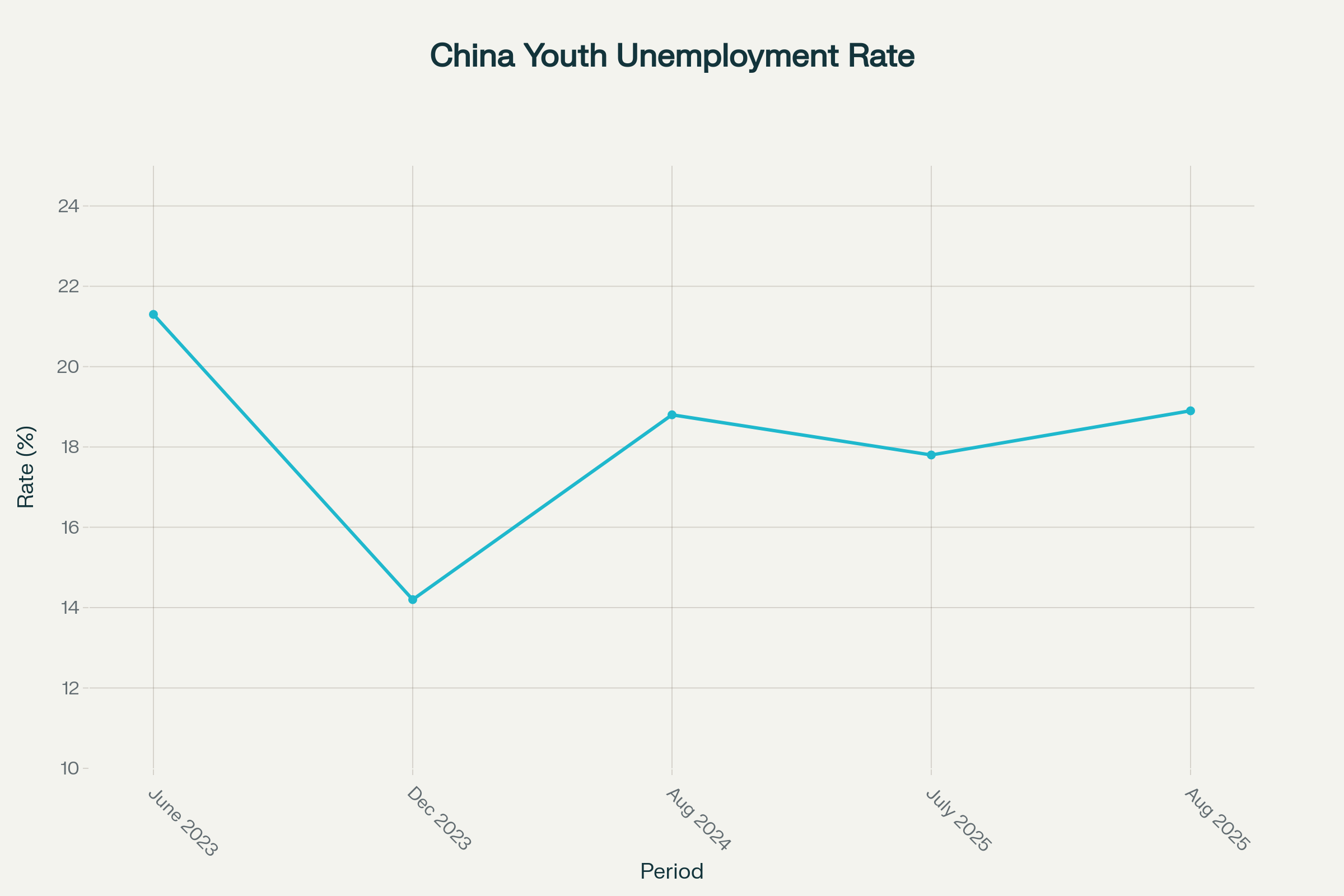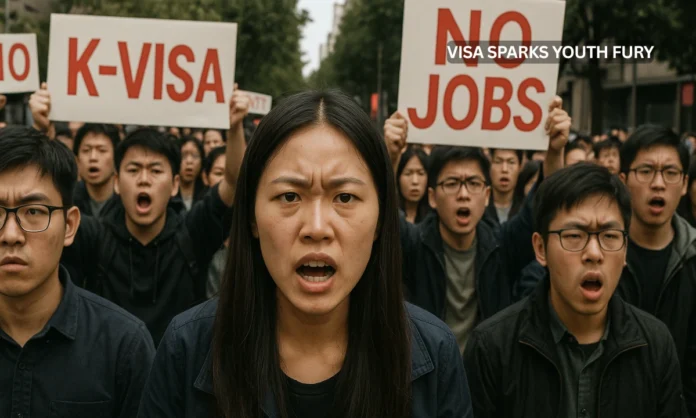Key Highlights:
- China K-visa program launched October 1, 2025, targeting foreign STEM graduates without requiring employer sponsorship
- Youth unemployment reached 18.9% in August 2025, affecting a record 12.2 million new graduates entering the job market
- Social media discussions about the China K-visa program generated half a billion views in two days, reflecting widespread domestic opposition
China’s introduction of the China K-visa program has ignited fierce domestic opposition as the country’s youth unemployment crisis deepens, creating a stark contradiction between Beijing’s global talent ambitions and rising joblessness among educated young Chinese citizens. The new China K-visa program, launched October 1, 2025, allows foreign science and technology professionals to enter China without prior employment offers, marking a significant departure from traditional visa requirements that demanded employer sponsorship. This policy shift comes as China faces mounting economic pressures and seeks to attract international talent while domestic graduates struggle in an increasingly competitive job market.
The timing of China’s K-visa program appears strategically coordinated with recent changes to America’s H-1B visa program, where President Donald Trump imposed a $100,000 application fee for skilled foreign workers. This dramatic policy contrast positions the China K-visa program as an alternative destination for international talent at precisely the moment when the United States is restricting access to its own skilled worker programs.
Youth Unemployment Reaches Critical Levels
China’s youth unemployment crisis has reached alarming proportions, with the jobless rate for 16-24 year-olds excluding students climbing to 18.9% in August 2025, representing the highest level since December 2023 when Beijing revised its calculation methodology. This figure marks a sharp increase from 17.8% in July 2025 and surpasses the previous year’s rate of 18.8% in August 2024. The unemployment surge coincides with a record 12.2 million university graduates entering the workforce in 2025, creating unprecedented competition for available positions amid criticism of the China K-visa program.
- The current unemployment rate represents nearly three times the national urban average of 5.3% for all age groups
- China’s statistics bureau previously suspended youth unemployment data releases in June 2023 after rates hit a record 21.3%
The economic challenges facing young job seekers extend beyond simple supply and demand imbalances, reflecting deeper structural issues within China’s labor market that have amplified opposition to the China K-visa program. Manufacturing sectors face shortages of nearly 30 million workers, while emerging industries like artificial intelligence, renewable energy, and electric vehicles project demand for over 12 million new positions by 2025. However, these opportunities often fail to align with graduate expectations and skill sets, creating a persistent mismatch between available jobs and qualified applicants.
Government initiatives to address the employment crisis have included organizing 112 recruitment fairs offering 2.6 million job postings and establishing online platforms connecting graduates with small and medium enterprises. Despite these efforts, the fundamental disconnect between graduate aspirations and market realities continues to drive unemployment rates higher, intensifying criticism of the China K-visa program.

China’s youth unemployment rate (16-24 age group, excluding students) shows volatile trends with the August 2025 rate reaching 18.9%, the highest since methodology changes in December 2023
China’s K-Visa Program Requirements and Strategic Objectives
The China K-visa program targets foreign professionals with bachelor’s degrees or higher in science, technology, engineering, and mathematics from recognized universities worldwide. Unlike traditional visa categories that require employer sponsorship, the China K-visa program allows applicants to enter China and subsequently seek employment opportunities, providing unprecedented flexibility for international talent. Chinese officials have positioned this policy as essential for maintaining competitive advantage in global technology sectors, particularly amid intensifying rivalry with the United States.
- The China K-visa program requires STEM qualifications from renowned institutions or active engagement in relevant research
- The visa allows participation in education, research, entrepreneurship, cultural exchange, and business activities
Beijing’s China K-visa program strategy directly challenges America’s restrictive immigration policies, offering an alternative pathway for skilled professionals previously targeting U.S. opportunities. The Communist Party’s official newspaper, People’s Daily, explicitly referenced this competitive positioning, stating that China has “astutely seized this important opportunity” while other countries tighten immigration controls. This messaging underscores Beijing’s broader ambition to establish China as a global technology powerhouse through strategic talent acquisition via the China K-visa program.
The absence of detailed implementation guidelines has created uncertainty about the China K-visa program application procedures, with Chinese embassy websites globally not yet offering applications despite the October 1 launch date. This administrative gap reflects the policy’s rushed timeline, potentially designed to capitalize quickly on American visa restrictions rather than ensure smooth operational execution of the China K-visa program.
Domestic Opposition and Social Media Backlash
Social media platforms across China have erupted with criticism of the China K-visa program, generating approximately 500 million views for related hashtags within just two days of the policy announcement. The overwhelming negative response reflects deep-seated frustrations among educated young Chinese citizens who view the China K-visa program as prioritizing foreign talent over domestic job seekers. Comments gaining thousands of likes have questioned the logic of implementing the China K-visa program when master’s degree holders struggle to find employment within China.
- Nationalist and xenophobic sentiments have emerged in online discussions about the China K-visa program, with particular bias against potential Indian applicants
- Critics argue that the China K-visa program’s bachelor’s degree requirements are insufficiently rigorous for such preferential treatment
The domestic backlash highlights fundamental tensions between Beijing’s economic development strategy and citizen welfare concerns regarding the China K-visa program. Former Global Times editor Hu Xijin acknowledged that controversy surrounding the China K-visa program reflects “tension in the domestic job market and the anxiety young people face in finding employment”. This official recognition of public concerns suggests government awareness of the China K-visa program’s domestic political risks.
Chinese authorities have attempted to address criticism through official media channels, with People’s Daily editorials arguing that the China K-visa program should not be equated with permanent immigration but rather represents temporary talent facilitation. However, these explanations have failed to mollify public opposition to the China K-visa program, which appears rooted in broader economic insecurities rather than specific policy details.
Global Talent Competition and Economic Implications
China’s foreign resident population remains exceptionally small by international standards, with only 845,697 foreign nationals living on the mainland according to 2020 census data, representing just 0.06% of the total population, creating challenges for the China K-visa program implementation. This minimal foreign presence contrasts sharply with developed economies like the United States (15.4%), Germany (15.7%), and even regional neighbors like Japan (2.0%) and South Korea (2.3%). The China K-visa program represents Beijing’s recognition that attracting international talent requires structural policy changes rather than incremental adjustments.
- Shanghai leads China in foreign talent concentration, with 18% of foreign residents classified as high-end professionals, potentially benefiting from the China K-visa program
- The city hosts 767 regional multinational headquarters and 479 research and development centers
China’s existing R-visa category already accommodates “foreigner of high talent or specialists urgently needed by the State,” but the China K-visa program’s reduced barriers suggest acknowledgment that previous programs were insufficiently attractive. The new policy’s emphasis on young professionals reflects strategic focus on long-term talent development rather than immediate skill gaps through the China K-visa program. This approach aligns with China’s broader technological competition objectives, particularly in artificial intelligence, semiconductor development, and advanced manufacturing sectors.
The China K-visa program’s success will largely depend on China’s ability to create attractive employment conditions and career advancement opportunities for international professionals. Current economic challenges, including property sector weakness and deflationary pressures, may limit the China K-visa program’s effectiveness regardless of visa accessibility improvements. Additionally, concerns about China’s business environment, regulatory uncertainty, and geopolitical tensions could deter potential applicants from the China K-visa program despite favorable immigration terms.
Closing Assessment
The China K-visa program represents a bold attempt to capitalize on America’s restrictive immigration policies while addressing domestic technological development needs, yet its launch amid record youth unemployment exposes fundamental contradictions in Beijing’s economic strategy. The initiative’s domestic backlash reflects broader anxieties about economic opportunity and national priorities, suggesting that successful talent attraction through the China’s K-visa program requires addressing citizen concerns alongside policy innovation. As China navigates between global competitiveness and domestic stability, the China’s K-visa program controversy serves as a crucial test of the government’s ability to balance international ambitions with popular sentiment in an era of economic uncertainty.


